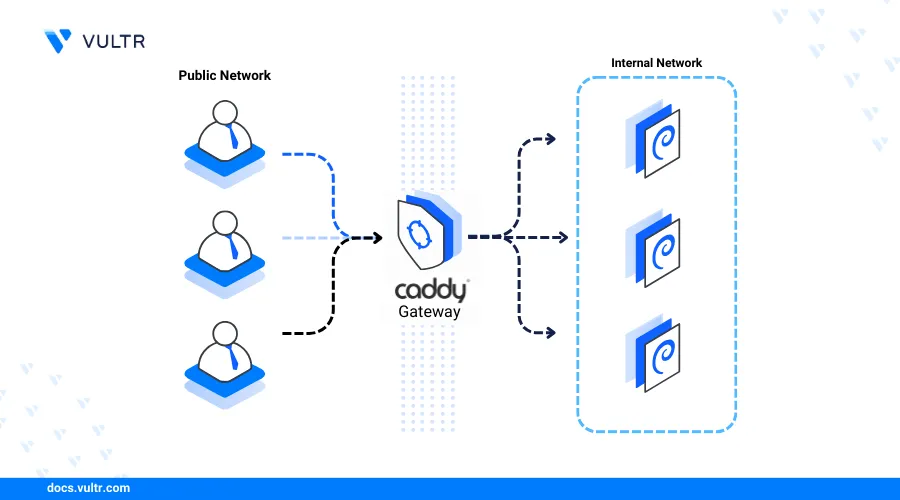
Introduction
Caddy is an open-source webserver that enables the deliver of dynamic web applications with automatic TLS/SSL termination. Caddy can work as a webserver, reverse proxy, load balancer, or API gateway to securely deliver applications or services using site block configurations.
This article explains how to install the Caddy webserver on Debian 12.
Prerequisites
Before you begin:
- Deploy a Debian 12 server on Vultr.
- Create a domain name A record pointing to the server IP address.
- Securely access the server using SSH as a non-root sudo user.
- Update the server.
Install Caddy
Caddy is not available in the Debian 12 package repositories by default but can be installed from source files or through the latest repository information on your server. Follow the steps below to download the latest Caddy repository information and install the application on your server.
Update the server's package index.
console$ sudo apt update
Install all necessary dependency packages.
console$ sudo apt install -y debian-keyring debian-archive-keyring apt-transport-https curl
Import the Caddy repository GPG key.
console$ curl -1sLf 'https://dl.cloudsmith.io/public/caddy/stable/gpg.key' | sudo gpg --dearmor -o /usr/share/keyrings/caddy-stable-archive-keyring.gpg
Add the Caddy repository to your APT sources.
console$ curl -1sLf 'https://dl.cloudsmith.io/public/caddy/stable/debian.deb.txt' | sudo tee /etc/apt/sources.list.d/caddy-stable.list
Update the server's package index again.
console$ sudo apt update
Install Caddy.
console$ sudo apt install caddy
View the installed Caddy version on your server.
console$ caddy version
You output should be similar to the one below.
v2.8.4 h1:q3pe0wpBj1OcHFZ3n/1nl4V4bxBrYoSoab7rL9BMYNk=Allow incoming connections to the HTTP port
80through the firewall.console$ sudo ufw allow 80
Restart the firewall to apply changes.
console$ sudo ufw reload
Access your Server IP using a web browser such as Chrome and verify that Caddy delivers the default web application page.
http://SERVER-IP
Manage the Caddy System Service
Follow the steps below to manage Caddy as a system service on your server.
Enable the Caddy system service to automatically start at boot.
console$ sudo systemctl enable caddy
Start the Caddy service.
console$ sudo systemctl start caddy
View the Caddy service status and verify that it's running.
console$ sudo systemctl status caddy
Your output should look like the one below:
● caddy.service - Caddy Loaded: loaded (/lib/systemd/system/caddy.service; enabled; preset: enabled) Active: active (running) since Mon 2024-07-22 16:59:15 UTC; 2h 54min ago Docs: https://caddyserver.com/docs/ Main PID: 7579 (caddy) Tasks: 7 (limit: 4637) Memory: 18.7M CPU: 202ms CGroup: /system.slice/caddy.service └─7579 /usr/bin/caddy run --environ --config /etc/caddy/Caddyfile
Create a New Caddy Virtual Host
Caddy stores configuration files in the /etc/caddy directory by default and supports Caddyfile configurations from any location on your server. Follow the steps below to create a new Caddy virtual host to serve web application files from the /var/www/example.com directory on your server.
Create a new
/var/www/example.comweb application files directory.console$ sudo mkdir -p /var/www/example.com
Create a new HTML application file
index.html.console$ sudo nano /var/www/example.com/index.html
Add the following contents to the
index.htmlfile.html<html> <head> <title>Greetings from Vultr!</title> </head> <body> <h1 align="center">Hello world!, Greetings from Vultr</h1> <h1 align="center">Success! The Caddy server is working!</h1> </body> </html>
Save and close the file.
Switch to the Caddy configuration files directory.
console$ cd /etc/caddy/
Back up the default Caddyfile configuration.
console$ sudo mv Caddyfile Caddyfile.default
Create a new Caddyfile configuration.
console$ sudo nano Caddyfile
Add the following configurations to the file. Replace
example.comwith your actual domain.iniexample.com { tls admin@example.com root * /var/www/example.com file_server { index index.html } log { output file /var/log/caddy/example.log format console } }
Save and exit the file.
The above Caddy configuration creates a new virtual host and delivers web application files using your domain
example.com. Within the configuration:example.com: Defines a new virtual host entry for your domain or IP address.tls: Specifies the email address to associate with Let's Encrypt SSL certificate generation requests.root: Specifies the directory where your web application files are stored.file_server: Activates the file server for your web application. Within the directive,indexspecifies the default file to serve when your domain is accessed.log: Enables logging of access and error details to a specific file such as/var/log/caddy/example.log.
Test the Caddy configuration for errors.
console$ caddy validate
Output:
2024/07/25 17:21:59.158 INFO http.auto_https enabling automatic HTTP->HTTPS redirects {"server_name": "srv0"} 2024/07/25 17:21:59.158 INFO tls.cache.maintenance started background certificate maintenance {"cache": "0xc0000ef200"} 2024/07/25 17:21:59.158 INFO tls.cache.maintenance stopped background certificate maintenance {"cache": "0xc0000ef200"} Valid configurationReload the Caddy service to apply the configuration changes.
console$ sudo systemctl reload caddy
Secure the Caddy Webserver
Caddy automatically generates and renews trusted Let's Encrypt SSL certificates from for all site blocks with domain values. Follow the steps below to secure access to the Caddyfile configuration and allow network connections to all necessary network connection ports.
Grant the Caddy user full privileges to the
/etc/caddydirectory.console$ sudo chown -R caddy:caddy /etc/caddy
Grant the Caddy user full permissions to the Caddyfile while disabling access for other system users.
console$ sudo chmod 660 /etc/caddy/Caddyfile
Long list the
/etc/caddydirectory to verify the permission changes.console$ ls -l /etc/caddy/
Output:
total 8 -rw-rw---- 1 caddy caddy 244 Jul 25 17:18 Caddyfile -rw-r--r-- 1 caddy caddy 769 Jun 2 12:07 Caddyfile.default
Set Up Firewall Rules
Caddy uses the HTTP port 80 and HTTPS port 443 to serve web application files on your server. Follow the steps below to configure the default firewall to allow connections to all network ports required by the Caddy webserver.
View the UFW status and verify that it's active.
console$ sudo ufw status
If the status is
inactive, allow the SSH port22and enable UFW.console$ sudo ufw allow 22 && sudo ufw enable
Allow incoming connections to the HTTPS port
443.console$ sudo ufw allow 443
Reload the firewall to apply changes.
console$ sudo ufw reload
View the firewall status.
console$ sudo ufw status
Access your domain using a browser such as Chrome to verify that Caddy serves your virtual host's web application files.
https://example.com
Conclusion
You have installed Caddy on a Debian 12 server and managed the application service to securely deliver web applications. Caddy can work as a webserver or a reverse proxy to securely deliver applications or services. For more information and configuration options, visit the Caddy documentation.